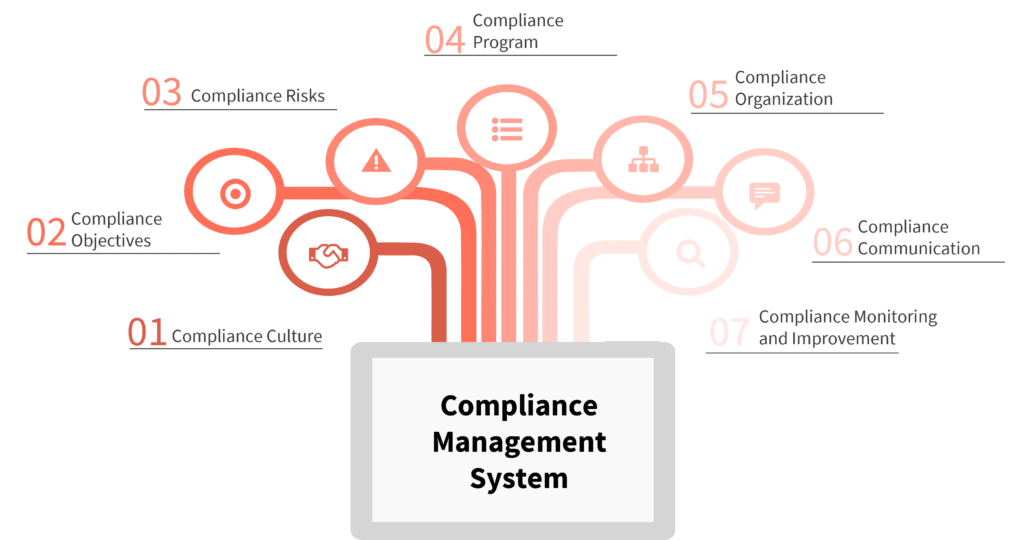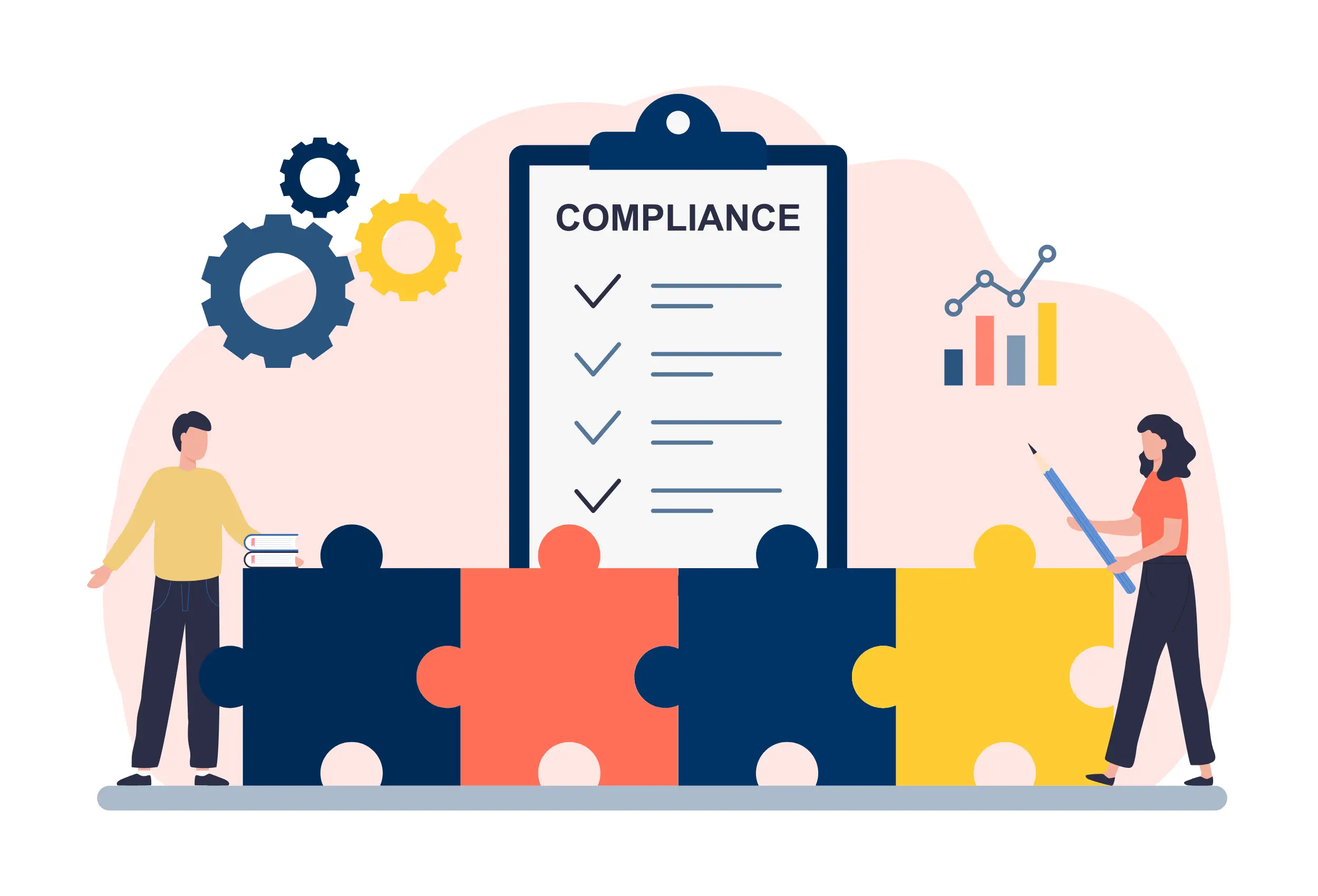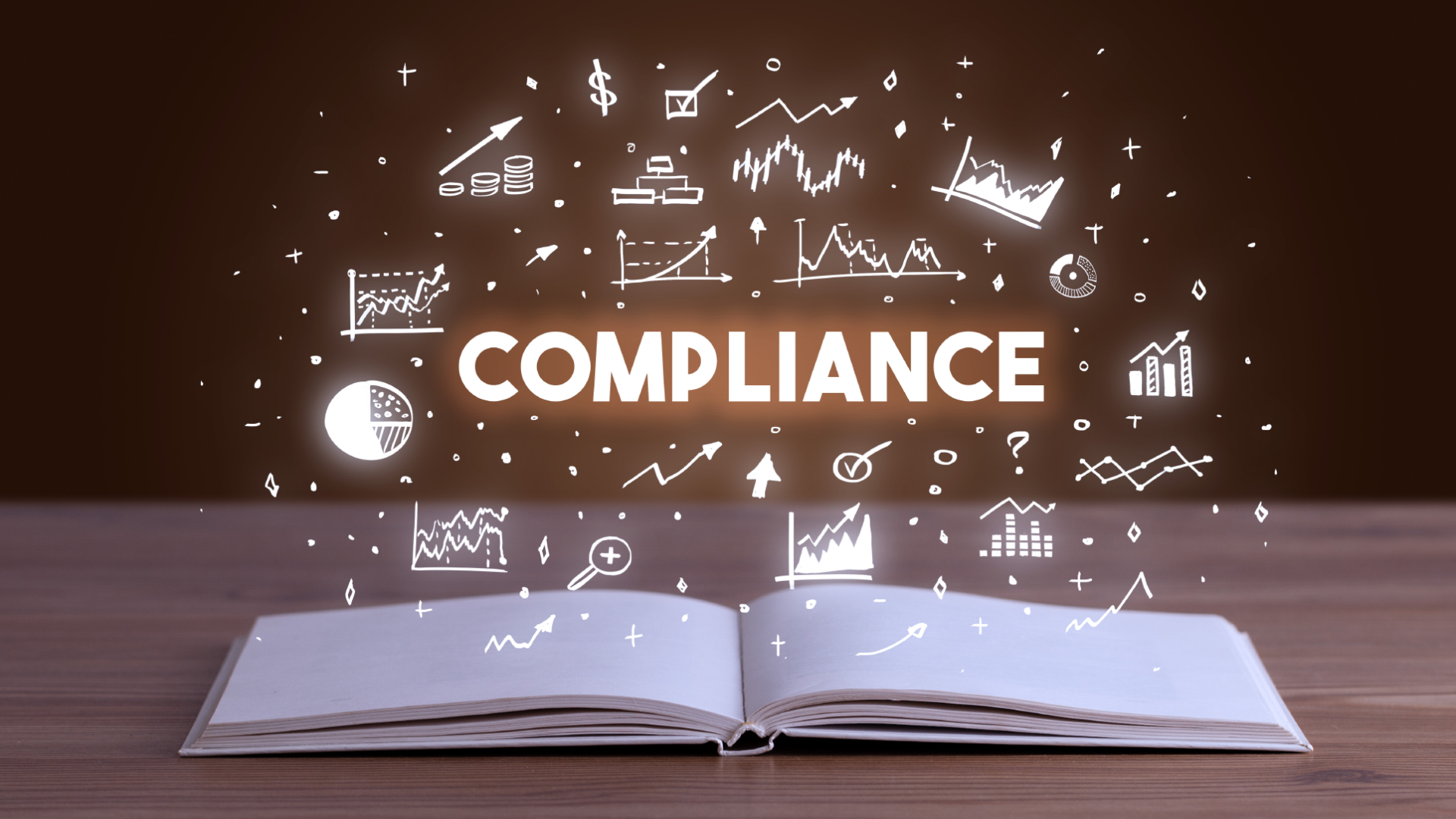Found this helpful? Share it with peers.
Introduction
In today’s rapidly evolving business landscape, ensuring compliance with regulations and standards has become a crucial aspect of organizational success. As compliance requirements tend to become increasingly complex and usually have to be implemented within a short period of time, efficient and flexible management is essential, regardless of whether you are a small business owner or a corporate executive.
In this blog post, we’d like to shed light on the importance of a Compliance Management System, from its definition to its essential components and key benefits.
What is a Compliance Management System?
The definition of a Compliance Management System is a framework that helps organizations ensure adherence to legal requirements, industry standards, and internal policies. It is a structured approach designed to identify, assess, monitor, and mitigate compliance risks across all levels of an organization. A well-designed Compliance Management System serves as a guiding compass, helping businesses navigate complex regulatory requirements while minimizing potential pitfalls. This makes it clear that a Compliance Management System is not only beneficial for large organizations, but also for smaller companies alike.
Now that we have the general background covered, let’s briefly discuss the responsibilities of management with respects to compliance.
What are the management’s responsibilities related to a Compliance Management System?
Within a Compliance Management System, management has the responsibility of setting the tone for compliance throughout the organization. Activities include defining the compliance strategy, establishing policies and procedures, assigning responsibilities, and fostering a culture of compliance. Effective leadership ensures that compliance is embedded in all areas of the organization, from board level to day-to-day operations.
What are the elements of a Compliance Management System?
The Auditing Standard 980 “Principles of Proper Auditing of Compliance Management Systems” from the IdW outlines essential parts of a Compliance Management System. These parts work together seamlessly and not only help auditors evaluate the system, but also offer valuable guidance for creating and putting it into action. The components include the following: compliance culture, compliance objectives, compliance risks, compliance programme, compliance organization, compliance communication and compliance monitoring and improvement. Let’s have a look at each element in more detail below.

Elements of a Compliance Management System
1. Compliance culture
A strong compliance culture is both the foundation and the result of a successful Compliance Management System. A sustainable compliance culture is derived from the company’s overall values and understanding of risk, and is based on consistent and clear communication by the company’s management. This “tone from the top” is supported by instruments such as a clear code of conduct that is easily accessible to all employees.
2. Compliance objectives
Compliance objectives are also an essential component of a Compliance Management System. Only by setting clear and measurable objectives can the organization’s compliance efforts be managed. Compliance objectives should be consistent with legal requirements, industry standards, and the organization’s overall goals and values.
3. Compliance risks
The Compliance Management System focuses on minimizing compliance risks. Continuous monitoring of legal regulations and requirements forms the basis for a structured and holistic risk assessment. In addition, a comprehensive risk analysis must be conducted at regular intervals. This requires a good understanding of the company’s specific business areas and key processes.
4. Compliance programme
The compliance programme comprises all initiatives aimed at minimizing compliance risks (and thus breaches of rules) and taking the necessary steps in the event of identified breaches. Depending on the objective or scope, the programme consists of the Internal Control System, the establishment of a possibility to report violations (“whistleblower hotline”) and other incentives to promote compliance.
5. Compliance organization
The purpose of the compliance organization is to organize and document roles, responsibilities, tasks, rights and obligations. For example, a compliance officer should be appointed to oversee and coordinate compliance activities. His or her responsibilities include training, monitoring, reporting, and ensuring compliance with relevant laws and regulations.
6. Compliance communication
Effective communication is key to ensuring the flow of compliance-related information within the organization. In this context, internal communication includes day-to-day advice to management and operating units, compliance training, internal reporting and the establishment of confidential reporting channels for employees (whistleblowing system).
7. Compliance monitoring and improvement
Regular monitoring and evaluation of compliance activities are essential to identify gaps, measure performance, and ensure you meet policies and regulations. To improve even further, derive proper initiatives from monitoring results and received feedback.
Hint: Ensure Processes Compliance in 6 simple steps with our easy-to-follow guide.
Compliance Management System benefits
As mentioned above, there are a number of benefits to implementing a Compliance Management System that can be considered regardless of company size or industry.
Legal and regulatory adherence
The first advantage is already apparent from the definition and fundamental task of a Compliance Management System. It helps companies to comply with the laws and regulations applicable to their industry and thus reduce the risk of penalties, fines and sanctions.
Reduced risks
Compliance Management Systems help organizations identify and mitigate potential risks, minimizing legal penalties, reputational damage, and operational disruptions. By proactively managing compliance risks, organizations can avoid costly consequences and protect their interests.
Decreased costs
Investing in a Compliance Management System can lead to cost savings in the long run. By identifying and addressing compliance issues early on, organizations can avoid fines, lawsuits, and the need for extensive efforts. Effective compliance also reduces the likelihood of operational disruptions that can result in financial losses.
Improved efficiency
A well-functioning Compliance Management System improves communication and ensures consistent decision-making. Clear guidelines and processes also mean that employees automatically comply with all requirements, which subsequently leads to greater efficiency.

Compliance Management System implementation in 6 simple steps
Implementing a Compliance Management System is a strategic objective that requires careful planning and execution. By following a series of crucial steps, organizations can establish an effective system that ensures adherence to regulations and promotes a culture of compliance.
1. Assessment and planning
At the beginning of your compliance journey, it’s critical to take stock of the rules and standards that apply to your business. This includes identifying specific regulations, laws, and industry guidelines that govern your operations. By understanding the compliance landscape, you’ll be better prepared to align your business practices with these requirements. Take the time to evaluate your current compliance processes, policies, and procedures. This assessment will help you identify areas for improvement and lay the groundwork for your next steps. As you begin this process, determine the scope and objectives of your compliance management system. Also, assign roles and responsibilities to ensure effective oversight and management of compliance-related activities within your organization.
2. Policy development
Now that you have a clear understanding of the compliance rules that affect your business, it’s time to create your own set of guidelines. These guidelines, often referred to as compliance policies and procedures, provide a roadmap for your team to follow. Make sure these policies are written in a clear, concise, and easily understandable manner. These policies serve as the foundation of your compliance efforts, guiding your team on how to adhere to regulations and industry standards.
3. Risk assessment
Imagine you’re navigating a complex landscape filled with potential pitfalls. Risk assessment is your map to navigate this terrain safely. Identify potential compliance risks that your organization could face. These risks might include legal violations, financial losses, or damage to your reputation. Once you’ve identified these risks, evaluate the likelihood and potential impact of each one. This helps you prioritize which risks to address first. By focusing on the most significant risks, you ensure that your compliance efforts are well-targeted and effective.
4. Control implementation and execution
Define and implement controls to mitigate the identified risks. Align these controls with your existing policies. This integration ensures that your compliance efforts are consistent and comprehensive. Also focus on proper control execution. This is best done by obtaining confirmations from those responsible for the controls. Furthermore, you should also periodically review your controls for design and effectiveness.
5. Training and education
Provide comprehensive training programmes that educate employees on the compliance rules, policies, and procedures that apply to their roles. Regularly update these training materials to reflect changes in regulations or industry standards. By investing in employee training, you empower your team to make informed decisions and contribute to a culture of compliance awareness.
6. Monitoring and reporting
Establish a system to track compliance activities, measure adherence to policies, and identify potential gaps. Regular audits and assessments serve as a checkup for your compliance health. These audits not only help you catch and correct issues but also provide valuable insights into your overall compliance performance. Use this feedback to make necessary adjustments and refinements. Continuous improvement ensures that your compliance efforts remain effective and adaptable to changing circumstances.
Hint: Get our Compliance Management System Implementation Cheatsheet for takeaway!
Why use a Compliance Management System Software?
Software Tools for Compliance Management Systems, like our GRC-Tool ADOGRC, play a vital role in helping organizations effectively manage and streamline their compliance processes. They provide a comprehensive platform that centralizes compliance-related data, automates tasks, offers reporting capabilities, and ensures scalability and flexibility.
With Compliance Management System Software, organizations can consolidate their compliance-related information into a centralized repository. Such software tools offer easy and personalized access to policies, processes, controls, tasks, audit findings and more. It simplifies data and task management and ensures that the most up-to-date compliance information is readily available to authorized personnel.
Summary
Understanding the fundamentals of Compliance Management Systems is crucial for organizations seeking to successfully navigate complex regulatory environments and safeguard their reputation. A well-designed Compliance Management System helps to proactively manage compliance risks, reduce costs, enhance operational efficiency, resulting in a competitive advantage. Whether you’re a small business or a large corporation, embracing compliance management systems and leveraging software is key to sustainable success in today’s compliance-driven business world.






